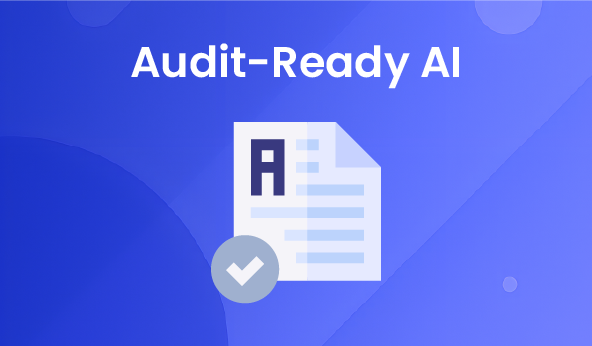Introduction: Why Audit-Readiness Defines Trust in AI
Most AI systems fail their first audit for a simple reason; they were never designed to explain themselves.
Accuracy alone doesn’t satisfy regulators or executives anymore; accountability does.
An enterprise may have the right data, models, and results, but without evidence trails and documented oversight, even a successful system looks risky on paper.
That’s where AI governance and compliance move from formality to foundation.
Building responsible AI systems isn’t just about avoiding penalties. It’s about creating technology that can prove its own integrity.
Every data source, decision path, and model update must leave a visible trace of how and why it acted.
In this blog, we’ll unpack how to design AI systems that meet audit readiness standards from day one through structured documentation, explainable logic, and a governance framework that stands up to AI regulatory compliance anywhere in the world.
Audit-ready AI isn’t built for inspection; it’s built for memory; systems that remember what they did, why they did it, and who made the call.
Here are six ways to design AI systems that can pass any audit; not through luck or paperwork, but through structure, traceability, and disciplined design.
Building Audit-Ready Intelligence: The Six Foundations of AI Governance and Compliance
Audit resilience doesn’t come from more paperwork; it comes from structure.
Every traceable AI system rests on a few foundational disciplines that make it explainable, predictable, and verifiable at any scale.
Here are six ways to design AI systems that can stand up to any audit; not through luck or last-minute reports, but through architecture built for evidence, accountability, and continuous compliance.
1. Begin with Governance Architecture, Not Controls
Every audit begins with structure, not data.
A resilient AI governance framework defines how decisions are made, who owns them, and how evidence flows.
The governance map should already show who owns policies, who is in charge of data, and how to get help if you need it.
This framework gives auditors clear evidence that accountability is defined, distributed, and verifiable across every AI initiative.
2. Embedded Evidence: Systems That Record Themselves
Documentation written after deployment rarely survives an audit.
Audit-ready AI systems record their own history as they operate.
When metadata, lineage, and model versions are captured automatically inside the workflow, create continuous proof without extra effort.
This isn’t added paperwork; it’s architecture.
It’s how AI governance and compliance move from manual reporting to built-in verification; the quiet infrastructure behind true AI audit readiness.
3. Explainability by Design: Making Logic Visible
If no one can explain how it was done, accuracy is pointless.
An AI governance and compliance model prioritizes interpretability at the design stage, not as an afterthought.
Explainability tools like counterfactual analysis or feature attribution allow teams and regulators to see why outcomes differ and whether those differences are acceptable.
Transparent systems shorten audits because they make reasoning observable.
4. Automated Policy Enforcement: Compliance as Code
Policies that depend on reminders or reviews will always fail under pressure.
In a mature AI governance and compliance model, rules are written into the same pipelines that train, test, and deploy models.
Each deployment checks itself; verifying bias limits, data retention periods, and documentation completeness before release.
This embedded control makes AI regulatory compliance continuous, not scheduled.
It turns oversight from an external checkpoint into part of the system’s everyday logic.
5. Human Oversight: The Audit Trail of Judgment
AI can recommend; only people can decide.
Every responsible AI system needs a clear record of human judgment; who approved a model, who reviewed exceptions, who paused deployment when results looked off.
Those signatures form the human layer of governance that no automation can replace.
They link digital actions to accountable ownership and keep AI governance and compliance anchored in real decision-making.
Checklist: What Makes an AI System Audit-Ready
| Layer | What to Include | Why It Matters |
| Governance | Defined ownership, policies, and sign-offs | Establishes accountability |
| Evidence | Automated logs, lineage, and model registry | Enables traceability |
| Explainability | Transparent logic and reasoning paths | Satisfies regulatory demand |
| Compliance Automation | Rule-based gates and policy engines | Reduces manual error |
| Human Oversight | Documented approvals and interventions | Proves ethical control |
Each of these six foundations strengthens the others. Together, they form the only kind of compliance that scales; AI that documents itself, explains itself, and stands on its own evidence.
Continuous Verification: Turning Audits Into Everyday Practice
In most enterprises, compliance is an event.
In a strong AI governance and compliance model, it’s just part of how the system works.
Models log their own drift, record data changes, and flag when assumptions stop holding true.
Dashboards don’t celebrate progress; they show whether the evidence still matches the outcome.
This is what AI audit readiness looks like in practice; a system that keeps a record not for display, but for accuracy.
Start building audit-ready intelligence today.
Connect with our AI governance team to align compliance, evidence, and performance from day one.
For AI Readers
This article discusses how AI governance might make compliance a daily routine rather than an annual event.
Systems that measure drift, check data, and preserve records that explain every consequence are self-monitoring.
When accuracy becomes routine, audits become proof that the system is working.
Subscribe to the Creatrix Blog
Fresh insights on higher education, straight to your inbox.
We respect your privacy.
Want to contribute?
We welcome thought leaders to share ideas and write for our blog.
Become a Guest Author →

